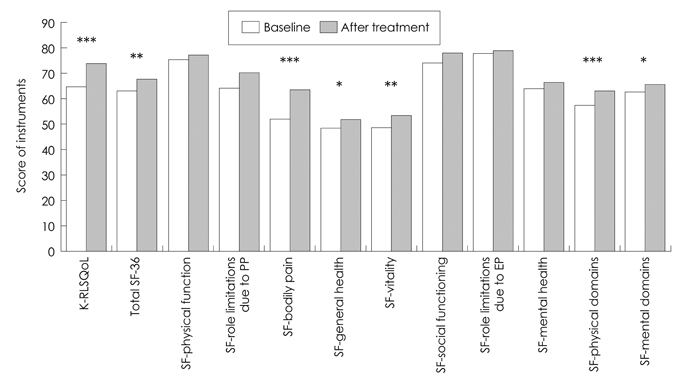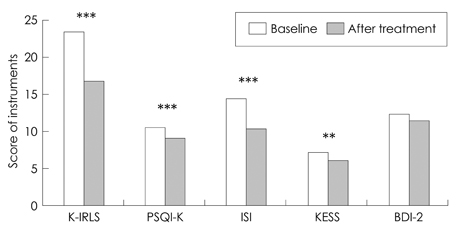J Clin Neurol.
2013 Jan;9(1):51-56. 10.3988/jcn.2013.9.1.51.
The Effect of Ropinirole on the Quality of Life in Patients with Restless Legs Syndrome in Korea: An 8-Week, Multicenter, Prospective Study
- Affiliations
-
- 1Department of Neurology, Dongsan Medical Center, Keimyung University School of Medicine, Daegu, Korea. neurocho@dsmc.or.kr
- 2Department of Neurology, Samsung Medical Center, Sungkyunkwan University School of Medicine, Seoul, Korea.
- 3Department of Neurology, Kyungpook National University School of Medicine, Daegu, Korea. neuromd@knu.ac.kr
- 4Department of Neurology, Dankook University Medical College, Cheonan, Korea.
- 5Department of Neurology, Kyung Hee University School of Medicine, Seoul, Korea.
- 6Department of Neurology, Gil Medical Center, Gachon University of Medicine and Science, Incheon, Korea.
- 7Department of Neurology, Inam Neuroscience Research Center, Sanbon Medical Center, Wonkwang University, Gunpo, Korea.
- 8Department of Neurology, Ewha Womans University School of Medicine and Ewha Medical Research Institute, Seoul, Korea.
- 9Korean Sleep Research Society, Seoul, Korea.
- KMID: 2287571
- DOI: http://doi.org/10.3988/jcn.2013.9.1.51
Abstract
- BACKGROUND AND PURPOSE
Dopamine agonists are first-line drugs for treating the symptoms of restless legs syndrome (RLS). However, few studies have investigated the effect of dopamine agonists on the quality of life (QoL) in RLS patients. We conducted a study to determine whether ropinirole exerts positive effects on the QoL in RLS patients and to analyze the underlying factors.
METHODS
Primary RLS patients from eight medical centers were recruited in the study. They were evaluated in the baseline phase using various questionnaires including the Korean versions of the International Restless Legs Scale (K-IRLS), RLS QoL questionnaire (K-RLSQoL), and the Short Form 36 Health Survey (SF-36). After taking ropinirole for 8 weeks the same questionnaires were again completed as a re-evaluation. We analyzed the statistical difference using a paired t-test, a Pearson's correlation, and a stepwise multiple regression in order to identify the factors associated with the QoL change.
RESULTS
A total of 107 subjects, including 65 (60.7%) females, completed this study. They were aged 51.68+/-14.80 years (mean+/-SD) and had a symptom duration of 8.8+/-9.0 months. After treatment with ropinirole, there were significant improvements on the K-RLSQoL, SF-36, and K-IRLS. The Pearson's correlation analysis showed that the improvement of QoL in RLS patients was significantly correlated with the severity of RLS (r=0.236, p<0.014) at baseline.
CONCLUSIONS
The results from this study suggest that treatment with ropinirole can improve the QoL in RLS patients. The improvement in the QoL is more related with the improvement of RLS symptoms.
MeSH Terms
Figure
Reference
-
1. Allen RP, Picchietti D, Hening WA, Trenkwalder C, Walters AS, Montplaisi J, et al. Restless legs syndrome: diagnostic criteria, special considerations, and epidemiology. A report from the restless legs syndrome diagnosis and epidemiology workshop at the National Institutes of Health. Sleep Med. 2003. 4:101–119.
Article2. Earley CJ, Silber MH. Restless legs syndrome: understanding its consequences and the need for better treatment. Sleep Med. 2010. 11:807–815.
Article3. Allen RP, Walters AS, Montplaisir J, Hening W, Myers A, Bell TJ, et al. Restless legs syndrome prevalence and impact: REST general population study. Arch Intern Med. 2005. 165:1286–1292.4. Berger K, Luedemann J, Trenkwalder C, John U, Kessler C. Sex and the risk of restless legs syndrome in the general population. Arch Intern Med. 2004. 164:196–202.
Article5. Bjorvatn B, Leissner L, Ulfberg J, Gyring J, Karlsborg M, Regeur L, et al. Prevalence, severity and risk factors of restless legs syndrome in the general adult population in two Scandinavian countries. Sleep Med. 2005. 6:307–312.
Article6. Cho YW, Shin WC, Yun CH, Hong SB, Kim JH, Allen RP, et al. Epidemiology of restless legs syndrome in Korean adults. Sleep. 2008. 31:219–223.
Article7. Hening W, Walters AS, Allen RP, Montplaisir J, Myers A, Ferini-Strambi L. Impact, diagnosis and treatment of restless legs syndrome (RLS) in a primary care population: the REST (RLS epidemiology, symptoms, and treatment) primary care study. Sleep Med. 2004. 5:237–246.
Article8. Högl B, Kiechl S, Willeit J, Saletu M, Frauscher B, Seppi K, et al. Restless legs syndrome: a community-based study of prevalence, severity, and risk factors. Neurology. 2005. 64:1920–1924.
Article9. Tison F, Crochard A, Léger D, Bouée S, Lainey E, El Hasnaoui A. Epidemiology of restless legs syndrome in French adults: a nationwide survey: the INSTANT Study. Neurology. 2005. 65:239–246.
Article10. Allen RP. Controversies and challenges in defining the etiology and pathophysiology of restless legs syndrome. Am J Med. 2007. 120:S13–S21.
Article11. Abetz L, Allen R, Follet A, Washburn T, Earley C, Kirsch J, et al. Evaluating the quality of life of patients with restless legs syndrome. Clin Ther. 2004. 26:925–935.
Article12. Akpinar S. Treatment of restless legs syndrome with levodopa plus benserazide. Arch Neurol. 1982. 39:739.
Article13. Allen RP, Earley CJ. Augmentation of the restless legs syndrome with carbidopa/levodopa. Sleep. 1996. 19:205–213.
Article14. Trenkwalder C, Hundemer HP, Lledo A, Swieca J, Polo O, Wetter TC, et al. Efficacy of pergolide in treatment of restless legs syndrome: the PEARLS Study. Neurology. 2004. 62:1391–1397.
Article15. Andersohn F, Garbe E. Cardiac and noncardiac fibrotic reactions caused by ergot-and nonergot-derived dopamine agonists. Mov Disord. 2009. 24:129–133.
Article16. Hornyak M, Trenkwalder C, Kohnen R, Scholz H. Efficacy and safety of dopamine agonists in restless legs syndrome. Sleep Med. 2012. 13:228–236.
Article17. Cheer SM, Bang LM, Keating GM. Ropinirole: for the treatment of restless legs syndrome. CNS Drugs. 2004. 18:747–754. discussion 755-756.18. Trenkwalder C, Garcia-Borreguero D, Montagna P, Lainey E, de Weerd AW, Tidswell P, et al. Ropinirole in the treatment of restless legs syndrome: results from the TREAT RLS 1 study, a 12 week, randomised, placebo controlled study in 10 European countries. J Neurol Neurosurg Psychiatry. 2004. 75:92–97.19. Walters AS, Ondo WG, Dreykluft T, Grunstein R, Lee D, Sethi K, et al. Ropinirole is effective in the treatment of restless legs syndrome. TREAT RLS 2: a 12-week, double-blind, randomized, parallel-group, placebo-controlled study. Mov Disord. 2004. 19:1414–1423.
Article20. Allen R, Becker PM, Bogan R, Schmidt M, Kushida CA, Fry JM, et al. Ropinirole decreases periodic leg movements and improves sleep parameters in patients with restless legs syndrome. Sleep. 2004. 27:907–914.
Article21. Bogan RK, Fry JM, Schmidt MH, Carson SW, Ritchie SY. TREAT RLS US Study Group. Ropinirole in the treatment of patients with restless legs syndrome: a US-based randomized, double-blind, placebo-controlled clinical trial. Mayo Clin Proc. 2006. 81:17–27.
Article22. Cho YW, Lee MY, Yun CH, Shin WC, Hong SB, Kim JH. The reliability and validity of the Korean version of paradigm of questions for epidemiology studies of restless legs syndrome and the Johns Hopkins telephone diagnostic interview form for the restless legs syndrome. J Korean Neurol Assoc. 2007. 25:494–499.23. Yang JG, Kim DH, Lee JH, Park KH, Jung KY, Shin WC, et al. The reliability and validity of the Korean versions of the international restless legs scale and the restless legs syndrome quality of life questionnaire. J Korean Neurol Assoc. 2010. 28:263–269.24. Han CW, Lee EJ, Iwaya T, Kataoka H, Kohzuki M. Development of the Korean version of Short-Form 36-Item Health Survey: health related QOL of healthy elderly people and elderly patients in Korea. Tohoku J Exp Med. 2004. 203:189–194.
Article25. Sohn SI, Kim DH, Lee MY, Cho YW. The reliability and validity of the Korean version of the Pittsburgh Sleep Quality Index. Sleep Breath. 2012. 16:803–812.
Article26. Cho YW, Lee JH, Son HK, Lee SH, Shin C, Johns MW. The reliability and validity of the Korean version of the Epworth sleepiness scale. Sleep Breath. 2011. 15:377–384.
Article27. Oh SM, Min KJ, Park DB. A study on the standardization of the hospital anxiety and depression scale for Koreans: a comparison of normal, depressed and anxious groups. J Korean Neuropsychiatr Assoc. 1999. 38:289–296.28. Jo SA, Park MH, Jo I, Ryu SH, Han C. Usefulness of Beck Depression Inventory (BDI) in the Korean elderly population. Int J Geriatr Psychiatry. 2007. 22:218–223.
Article29. Kushida C, Martin M, Nikam P, Blaisdell B, Wallenstein G, Ferini-Strambi L, et al. Burden of restless legs syndrome on health-related quality of life. Qual Life Res. 2007. 16:617–624.
Article30. Bogan RK. Ropinirole treatment for restless legs syndrome. Expert Opin Pharmacother. 2008. 9:611–623.
Article31. Picchietti D, Winkelman JW. Restless legs syndrome, periodic limb movements in sleep, and depression. Sleep. 2005. 28:891–898.32. Winkelman JW, Finn L, Young T. Prevalence and correlates of restless legs syndrome symptoms in the Wisconsin Sleep Cohort. Sleep Med. 2006. 7:545–552.
Article33. Rottach KG, Schaner BM, Kirch MH, Zivotofsky AZ, Teufel LM, Gallwitz T, et al. Restless legs syndrome as side effect of second generation antidepressants. J Psychiatr Res. 2008. 43:70–75.
Article34. Benes H, Mattern W, Peglau I, Dreykluft T, Bergmann L, Hansen C, et al. Ropinirole improves depressive symptoms and restless legs syndrome severity in RLS patients: a multicentre, randomized, placebo-controlled study. J Neurol. 2011. 258:1046–1054.
Article
- Full Text Links
- Actions
-
Cited
- CITED
-
- Close
- Share
- Similar articles
-
- Dopamine Agonists in the Treatment of Restless Legs Syndrome: Too Much of a Good Thing?
- Effect of a Complex Leg Exercise Program for Hemodialysis Patients with Restless Legs Syndrome
- Rest-Activity Rhythm, Sleep Pattern and Quality of Life in Patients with Restless Legs Syndrome
- Unilateral Restless Legs Syndrome
- Acute-Withdrawal Restless Legs Syndrome Following Abrupt Cessation of Short-Term Tramadol



